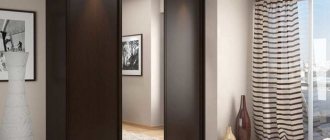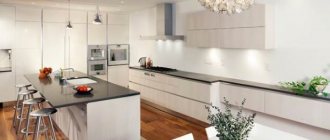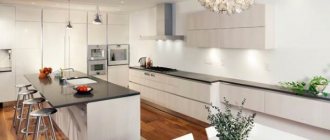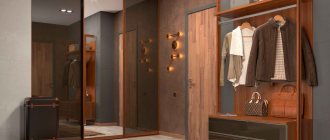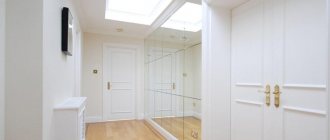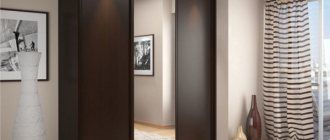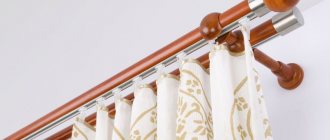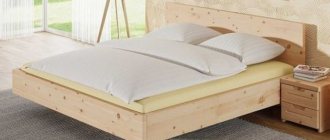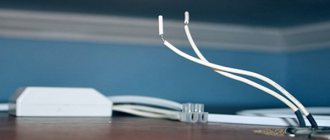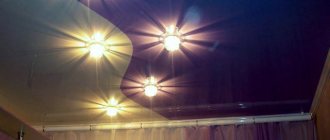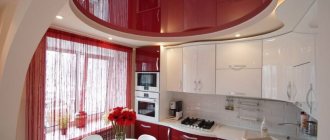Benefits of installing closet lighting
Cabinet lighting performs two functions at once: practical and decorative. Therefore, backlit products have significant advantages:
- illumination of the filling and contents of the cabinet allows you to quickly find the things you need in it;
- lighting in the area in front of the mirror increases the usability of the furniture;
- lighting elements allow you to diversify the design of furniture and make the interior of the room interesting and unique.
<
>
The lighting can be installed in any type of cabinet: traditional, wardrobe, kitchen furniture, bathroom cabinets and even shoe racks.
Advantages and disadvantages
For original interior decoration and creating a comfortable environment, designers recommend using recessed LED lighting in furniture products. LED options are the most popular today due to the improved characteristics and quality of the light bulbs. This type of lighting helps to realize all design ideas, even if the furniture is made independently.
Before going to a lighting and furniture store, you need to measure the length and width of the surface into which the lamp will be built: for large surfaces, it is wise to use several products to illuminate the space.
The main benefit of purchasing this type of lighting is related to compliance with all safety requirements: for furniture, it is important that the product does not heat the surface and does not create conditions for damage to objects. To better understand the principle of operation, it is worth highlighting a number of advantages that LED furniture lamps have:
- environmental friendliness - in this type of lighting, even if it is used to illuminate cabinets, there are no various types of harmful effects on health and the environment. This cannot be said about halogen lamps and fluorescent lamps. During operation, LEDs are not able to emit toxic substances, since they do not contain mercury;
- energy savings - using LED lamps you can save up to 60% of electricity. It is this indicator that distinguishes these products from the general assortment, making them the most popular when used on furniture;
- compactness and durability - thanks to its small size, it is possible to embed an LED light bulb even on a small surface. For example, such a lamp will look great on a small narrow strip of a sliding wardrobe, providing additional illumination;
- low dose of radiation - if we compare LEDs with luminescent analogues, the level of infrared radiation approaches zero. Therefore, there is no need to worry that the lamp will heat up the furniture or be hazardous to health;
- durability - manufacturers make lamps from durable materials. Often the body of the product is made of metal, glass or ceramics. In addition to increased strength indicators, this move adds a variety of color choices.
Like most different types of lamps, LED lamps have a number of disadvantages, the main one being high cost. If you ask yourself and go shopping, you can find quite acceptable options at an affordable price. In addition, when connecting lamps, additional equipment will be required to reduce the voltage in the network, since the products require a voltage of 12v.
Types of cabinet lighting
The modern furniture market offers a variety of types of cabinet lighting. This makes it possible to choose the option that seems most acceptable to the owner of the furniture.
There are four main types of cabinet lighting:
- halogen lamps;
- LED lights;
- fluorescent lamps;
- LED Strip Light.
Halogen cabinet lighting
Halogen lamps are the most common way to organize lighting in a closet. They are designs based on halogen lamps.
A halogen lamp is an incandescent lamp filled with a special gas (iodine or bromine vapor). It allows you to extend the service life of the product and significantly increase the heating temperature of the coil - up to 500.
Despite their brightness, halogen lamps have a number of significant disadvantages:
- high heating temperatures can melt the material from which the cabinet is made, as well as cause the evaporation of harmful substances. Therefore, halogen lamps are rarely built-in;
- they should not be touched with hands, otherwise greasy marks may remain on the lamp that cannot be erased;
- The halogen cabinet light is sensitive to even small power surges.
The best option for halogen lighting for a cabinet is several overhead lamps placed on its visor.
LED cabinet lighting
LED lighting combines several advantages: efficiency, durability, safety and high quality lighting.
LEDs are semiconductor devices with an electron-hole junction that generate light by passing electricity through it. This is the safest and most environmentally friendly lighting option.
LED lamps can be made in the form of a set of three or more individual light bulbs, as well as in the form of a line - a long lamp with several diodes arranged in a row.
Unlike halogen and fluorescent lamps, LEDs do not tend to get very hot. Therefore, they are ideal for organizing built-in lighting in cabinets made of any material (including chipboard), since they do not cause melting of the material and do not lead to the evaporation of phenol and other harmful substances.
Fluorescent backlight
Fluorescent lighting is used quite rarely. As a rule, it is used to illuminate the space in front of mirrors or as part of a trampoline rod.
Fluorescent lamps are gas-discharge light sources. The principle of their operation is to generate ultraviolet radiation by discharging current in mercury vapor. They are converted into light radiation using a special substance - phosphor. As a rule, it is a mixture of calcium halophosphate with other elements.
The main disadvantage of such lamps is the mercury content, which can cause serious harm to human health if the product breaks.
Mercury is classified as a class 1 toxic substance, so disposal of burnt-out fluorescent lamps in the usual way is unacceptable, as this causes damage to the environment.
Cabinet lighting with LED strip
An LED strip is a flexible board with contacts on which small diodes are located in a row. It is one of the most convenient lighting options and is often used for decorative purposes.
LED strip is sold in skeins of 5 meters or by meter. It is recommended to take accurate measurements before purchasing a backlight.
There are different options for LED strips that allow you to implement almost any idea in organizing furniture lighting:
- self-adhesive - it can be independently attached to various surfaces;
- waterproof - ideal for cabinets installed in rooms with high humidity, for example, in bathtubs;
- multi-colored RGB tape is an interesting option for decoration. In such a tape, you can change the color of the light bulbs using a controller.
Location options
Before you organize a wardrobe with lighting, or illuminate your dressing room, decide exactly how the strip or spotlights will be positioned.
Some use a recessed furniture lamp, while others prefer more modern LED strips that take up minimal space.
To connect LED strips, you must use a transformer. It's a power supply. And you need to choose a place to place it.
In total, there are several options for how lighting in a closet can be implemented:
- from the outside;
- in the middle on top of the cabinet;
- on the front edge of the shelves inside;
- on the rear edge of the shelves;
- along the side walls.
You can place lighting elements inside and outside the cabinet.
These are the top 5 ideas that are usually used.
On the other hand, lighting the glass shelves in the closet will look very beautiful and also provide the necessary practicality.
Furniture lighting should be installed in such a way that when using shelves, doors and drawers, they do not touch wires, lamps, as well as ribbons or the power supply.
Therefore, everything should be planned in advance.
Methods for installing lighting devices in a cabinet
The process of installing cabinet lighting requires care. It is advisable to think through its scheme in advance.
If lighting is installed from the mains, the cable can be routed in two ways:
- open - directly on the ceiling and wall;
- closed - using a cable channel.
Depending on the installation method, the following types of cabinet lighting are distinguished:
- mortise - built into pre-cut holes. Most often they are placed in canopies and separate sections of furniture. For a decorative function, lighting can be installed on the facade of the product;
- overhead – attached in those places where it is necessary. They can be of various shapes - square, round, oval, triangular and rectangular.
If bright lighting is required, it is advisable to use overhead lamps - they are more powerful than recessed ones.
Mortise structures are good to use for decorative purposes, but they are much more difficult to install.
Recommendations for illumination and light temperature
Kitchen lighting is included in the overall kitchen lighting project.
This refers to the illumination of the worktop and equipment, as well as the upper part of the set. Lighting for drawers or cabinets from the inside can be installed regardless of the lighting level in the room. The general requirement for a kitchen is 150 lux per square meter . The requirement is the same for the dining and working areas. To calculate the required lamp power, determine the illuminated area - usually the worktops and stove - and multiply the value by 150 lux.
The result is divided by the number of lamps that are supposed to be installed. Based on the results obtained, lamps of suitable power are selected.
You also need to take into account the temperature of the light . This indicator determines the shade. For functional lighting, warm white light with a temperature of 2700 K is recommended, natural daylight - 4200 K, and cold light - 6400 K.
Warm light is recommended for a large kitchen, cold light for a small one, as such lighting visually expands the space.
Installation locations of lamps in the closet
It is important to decide on the location where the lighting will be located. There are many options for its installation, depending on the purpose of the installation:
- on the doors. Such lighting performs more of a decorative function than a practical one. It can be used not only in a new cabinet - installing lighting on the doors of old furniture can significantly refresh it. As a rule, an LED strip is installed along the contour of the door;
- on the shelves of the closet. Lamps on the shelves illuminate their contents. These can be lamps of any type, except halogen ones - they get very hot and can damage things stored on the shelf;
- on the tramp rod. This solution allows you to illuminate the most spacious and deep compartment of the cabinet. It is made in the form of one long fluorescent lamp or LED strip;
- on the cabinet cornice - the protruding upper part of the product. This is a universal option, in which both the space in front of the cabinet and its internal contents are moderately illuminated. Traditionally, cornice lighting is done using several spotlights;
- in the lower base of the cabinet - used to illuminate the lower compartments, such lighting is especially relevant for shoe racks.
Illumination installed along the inner contour of the cabinet is gaining popularity - it allows you to illuminate almost the entire depth of the furniture.
Recommendations for lighting placement
A kitchen set is a complex complex of many elements. Some of its sections are illuminated for technical purposes, others for decorative purposes.
To create uniform lighting, use the following techniques.
Kitchen lighting for cabinets - panels, lamps, slots. It illuminates the countertop, stove surface, and washbasin. The hostess perfectly sees everything that happens on her table.
Illumination of individual zones - used more often in a small kitchen. Here it is enough to illuminate the stove, sink and, for example, the area with the microwave, so that you can see the surface of the countertop. However, the first task of such lighting is localization.
Lighting on the top of wall cabinets - usually on a specially installed panel. Allows you to do without overhead ceiling lighting and even at dusk to see the contents of the cabinets.
Interior lighting of drawers . Allows you to see their contents: utensils, cutlery, dishes, small appliances.
Under-table lighting is an expensive and rare option. LED strip or lamps are mounted on the reverse side of the panel and you get luminous tabletops. To realize this idea, you need to install a surface made of translucent material or glass.
Illumination of glazed facades helps to see the contents of wall cabinets, but behind the glass facade all objects are already clearly visible. Low warm lighting - golden, pinkish light - creates an amazing atmosphere of comfort.
Illumination of the lower part of the headset - mounted on a plinth. Makes massive floor cabinets look airy. It seems that the kitchen does not touch the floor and floats.
For decorative lighting, it is allowed to use colored LEDs or lampshades. However, this solution is rarely resorted to. White light is enough to create a visual impact.
Cabinet lighting controls
When choosing a backlight, pay attention to the control method.
It could be:
- control system using a switch. This is the easiest way. In order to turn on the lighting you must use the button. But turning the light on and off manually all the time is not always convenient, especially if the cabinet is used frequently;
- automatic control: the light turns on automatically when any of the doors is opened or at the moment when a person approaches the cabinet, and turns off when closed. This method is implemented using motion sensors.
To control the characteristics of the backlight - its brightness, intensity and color, a special controller or remote control is used.
Types of power supply systems
There are two types of cabinet lighting power supply:
- from the household electrical network - a reliable, but not the most convenient option. In this case, you will have to think about how to hide the wire. In addition, the backlight will not function in the event of a power outage;
- Autonomous - lamps are powered by batteries or rechargeable batteries. The first option is more budget-friendly, but the batteries are durable and guarantee high-quality power supply for the backlight.
Photos of illuminated cabinets
<
>
Thus, a closet with a lamp is not only convenient, but also beautiful. And the best solution for cabinet lighting in terms of functionality, safety and aesthetics is lighting in the form of LED lamps or strips, controlled automatically using a motion sensor.
